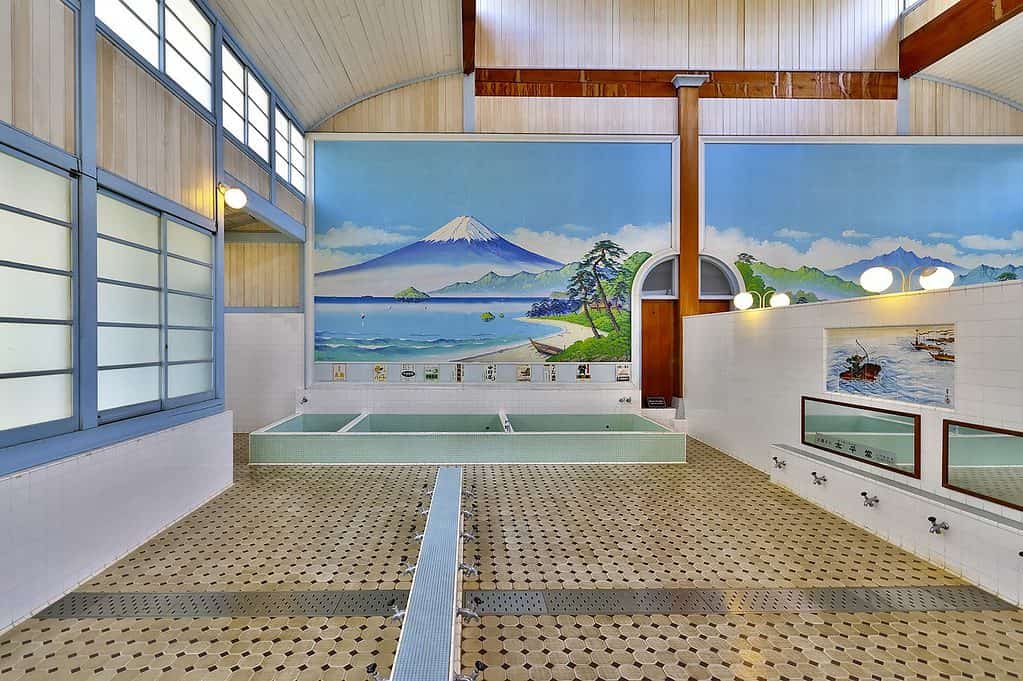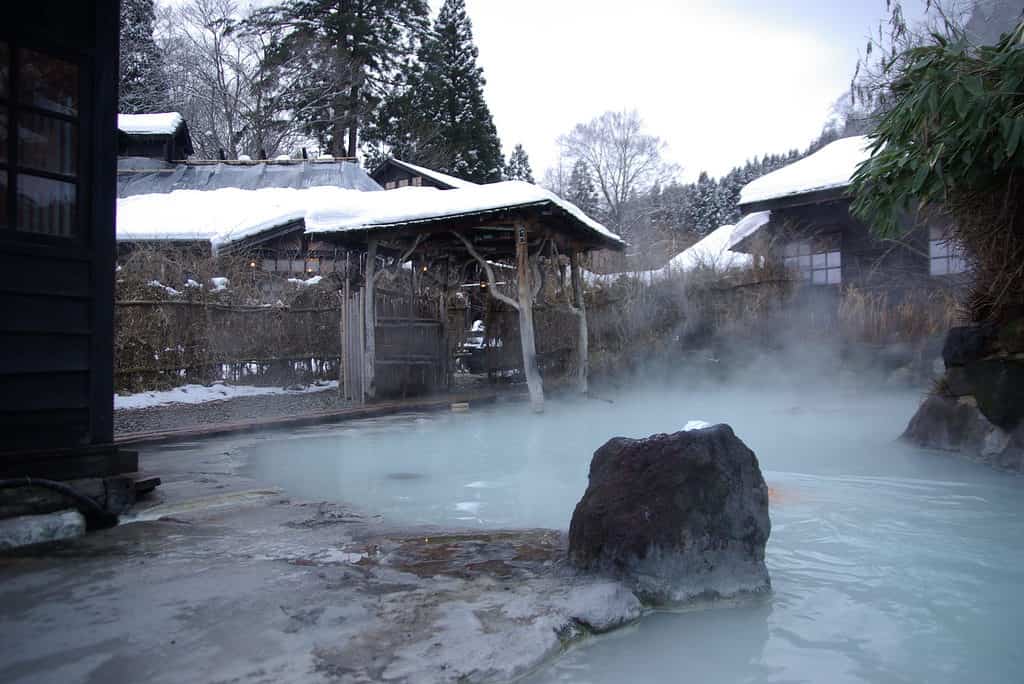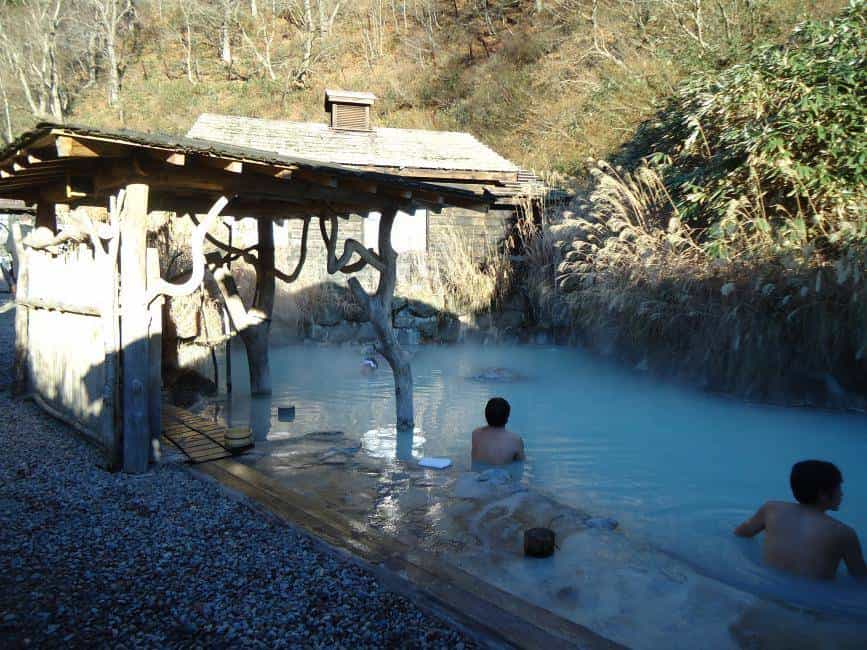“Onsen” is the Japanese word for the hot springs that can be found up and down the length of the country – from Okinawa in the south to Hokkaido in the north.
For the Japanese it is more than a popular pastime to soak in these natural thermal baths; it is a social activity, a health precaution, a time-honoured ritual, and a closely guarded facet of their cultural heritage. Though the thought may be daunting for most foreigners, bathing in an onsen is an unforgettable experience that no visitor to Japan should miss out on – which is why we’ve written this quick cheat sheet for first-time bathers.
From theme parks like Osaka Spa World to grand traditional institutions like Dogo Onsen; from giant baths carved from beaches and riverbeds to tiny city “sento” bathhouses – Japan has all manner of shapes and sizes of hot spring bath.

Onsen Etiquette for Beginners
The good news is that the rules are the same wherever you go. Whether you’re at the best onsen in Japan or a smaller onsen hotel, follow the same onsen etiquette and you’ll be fine.
1. Birthday suits only
This is the part that most foreigners find off-putting, but trust me – you’ll feel much more embarrassed when you accidentally walk in with your swimsuit on! Naked bathing may seem scary to you and me but for the Japanese it’s totally normal, and you’ll soon relax when you see that nobody else is batting an eyelid. So place all your belongings inside the locker allotted to you. You can take your own hand towel with you, but many onsens provide towels and hand towels, so just check beforehand.
2. Shower first, bathe after
Never, ever get into an onsen without first washing yourself thoroughly using the showers provided. It is an absolute must to wash yourself thoroughly before stepping into the bath. This is to keep the water as clean and hygienic as possible for your fellow bathers, and you will not be looked on favourably if you break this golden rule. Small stools, bowls and toiletries are provided for this purpose, and you are expected to sit down while you wash to avoid splashing your neighbours. Don’t shower or bathe while standing as you could splash water and soap onto other bathers. Take your own soap and washcloth along, or ask if the same is provided at the onsen.
3. Know your towels
Most onsen provide visitors with a set of towels (sometimes for a small fee), but smaller city bathhouses will expect you to bring your own. You will be given large towel for drying yourself, which should be left in the changing room with your clothes, and a small towel to be taken into the bath with you. You may use the small towel for washing under the shower and drying off excess water before you head back to the changing room, but never put it in the bathwater – most Japanese will put them on their heads while they soak.
Refrain from dipping your towel in the water. You can place it by the edge of the bath or balance it on your head, as most other bathers. If you drop it into the water by accident, wring it outside the bath.
4. No ducking
It is against onsen etiquette to submerge either your head or your hair in the water, so if you have long hair be sure to remember a hairband. This is to prevent strands of hair coming out in the bath, and to reduce the chance of spreading infection through the water. Nobody wants to deal with hairballs, and for your own hygiene, it’s the best thing to do.
5. No tattoos allowed
Heavily tattooed individuals might not be able to make it to the bathing area in most onsens and sentōs. That’s because tattoos are associated with the yakuza or mafia, and thus, taboo! Since tattoos are largely synonymous with organised crime in Japan, it has resulted in a blanket ban on body art across almost all onsen. If you have a small tattoo you will probably get away without anybody noticing, or you can choose to cover it with a sticking plaster or bandage. Even if you manage to sneak in with your tattoos, there’s a possibility that you’ll be asked to leave.
If your tattoos are impossible to cover, you will sadly be barred from visiting most hot springs in Japan. This rule tends to affect more foreigners than it does criminals, but unfortunately tattoos are a taboo that runs deep in Japanese society and it’ll be a long time before this changes. Your best chance to get the onsen experience in this case is to stay at a hotel that has private onsen baths, or visit a public hotel onsen late at night when all the other guests have gone to bed.
If you don’t mind having gang members as your bathing companions, there are some bathhouses catering specifically to yakuza where tattoos are allowed, but it’s not something we’d recommend!
6. Don’t drink and bathe
Since bathing at high temperatures can leave you a little light-headed (and take it from us, Japanese onsen are HOT!), you are advised not to drink alcohol before visiting the baths. Surprisingly, drunkenness, slippery floors and hot hot water don’t mix.
That said, a glass of wine or can of cold beer while you soak can be divine – so if you are lucky enough to have your own private onsen, enjoy in moderation!
7. Be modest
Modesty is appreciated and expected. So once you’ve scrubbed yourself and rinsed off well, use your hand towel to cover your privates as you head to the bath. Lower yourself into the water slowly without making splashes.
And what if you really can’t bear to bare?
For some people, the idea of public nudity really is an unassailable barrier to onsen enjoyment – but it doesn’t mean that you have to miss out. Whilst most onsen are open to the public, it is also possible to rent hotel rooms with private outdoor hot spring baths, which can be a great compromise.
Another alternative is to visit an onsen with opaque water. It sounds silly, but many onsen in Japan have milky or muddy coloured water, so once you’re submerged nobody can see a thing. Out of the water, you can use your small towel to preserve your modesty as you return to the changing rooms.

Types of Onsens
Onsens are of several types, all of which provide mental and physical relaxation to bathers. Depending on the minerals dissolved in the onsen water, these springs purportedly offer different health benefits too.
Onsens are classified according to their mineral composition. Sulphur hot springs are common in the mountain regions, hydrogen carbonate hot springs are characterized by fine bubbles forming on the bather’s skin, and iron hot springs are unmistakable with rust-colored water!
Apart from these, you’ll find alkaline soda, chloride, boric acid, and radium hot springs in various regions across Japan. You’ll also be astonished to see onsens with black, green, brown, and milky white water!
Check out these hot springs:
- Beppu Onsen in Oita, known for its ‘Blood Pond Hell’
- Goshiki Onsen, Nagano, where the water changes colors depending on weather and temperature
- Jigokudani Monkey Park, where you’ll get to see Japanese macaques enjoying hot water baths
What is Onsen?
Onsens are run by the municipality or privately as part of a hotel, bed and breakfast, or ryokan, a type of traditional Japanese inn. They can be indoor or outdoor baths, the latter known as roten-buro or noten-buro. Note that onsens only use water from geothermally heated springs; indoor public bath houses, called sentō, use heated tap water.
Furthermore, most onsens have segregated baths for men and women. Konyoku or mixed-gender onsens are banned in places like Tokyo, and persist only in certain rural areas of Japan. You do have the option of reserving a private onsen for yourself!
Mixed-gender onsens usually restrict women from walking around the facility and entering the bath without covering up with a towel or wearing a bathing suit. However, gender segregated baths require full nudity, as it is considered unclean to enter the bath with clothes on.
While this might be uncomfortable for certain individuals, in an onsen, nudity is natural. Most importantly, no one really cares what others look like. In addition to this, you’ll have a hand towel with you to cover your modesty for times when you’re outside of the water! When you’re in the water, there’s not much anyone will be able to see.
Remember: When in Rome…
Conclusion
Now that you know how elaborate bathing in Japan is, we’re sure you can’t wait to try out this tradition for yourself. So gear up for a trip filled with memories you’re sure to cherish for a lifetime.
Just keep the onsen etiquette tips given here in mind to have all the fun you deserve!
Insider Infographic Guide: How to Onsen
Taking a hot spring bath is one of the scariest experiences for newcomers to Japan, and the thought of communal bathing is enough to put many tourists off the idea altogether.
This is such a shame, because soaking in a steaming hot onsen bath – preferably in a beautiful natural setting, or with snow falling in drifts around you – is one of the most enjoyable and memorable experiences you can have in Japan (or any country for that matter).
Yes, you have to be naked. In front of people. We all found it difficult to begin with – but once you’ve dared to bare, you’ll never go back. Trust us.
Looking for the best Onsen in Japan?
Why not book a hotel with an onsen? Search for Ryokans in Japan – traditional Japanese accommodation below.













